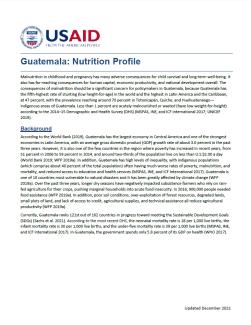According to the World Bank (2019), Guatemala has the largest economy in Central America and one of the strongest economies in Latin America, with an average gross domestic product (GDP) growth rate of about 3.0 percent in the past three years. However, it is also one of the few countries in the region where poverty has increased in recent years, from 51 percent in 2006 to 59 percent in 2014, and around two-thirds of the population live on less than U.S.$2.00 a day (World Bank 2019; WFP 2019a). In addition, Guatemala has high levels of inequality, with indigenous populations (which comprise about 40 percent of the total population) often having much worse rates of poverty, malnutrition, and mortality, and reduced access to education and health services (MSPAS, INE, and ICF International 2017). Guatemala is one of 10 countries most vulnerable to natural disasters and it has been greatly affected by climate change (WFP 2019a). Over the past three years, longer dry seasons have negatively impacted subsistence farmers who rely on rain-fed agriculture for their crops, pushing marginal households into acute food insecurity. In 2016, 900,000 people needed food assistance (WFP 2019a). In addition, poor soil conditions, over-exploitation of forest resources, degraded lands, small plots of land, and lack of access to credit, agricultural supplies, and technical assistance all reduce agricultural productivity (WFP 2019a).
Currently, Guatemala ranks 121st out of 162 countries in progress toward meeting the Sustainable Development Goals (SDGs) (Sachs et al. 2021). According to the most recent DHS, the neonatal mortality rate is 18 per 1,000 live births, the infant mortality rate is 30 per 1,000 live births, and the under-five mortality rate is 39 per 1,000 live births (MSPAS, INE, and ICF International 2017). In Guatemala, the government spends only 5.8 percent of its GDP on health (WHO 2017).

